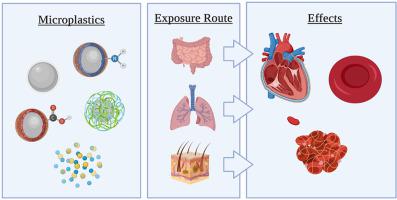Environmental Pollution ( IF 7.6 ) Pub Date : 2021-09-18 , DOI: 10.1016/j.envpol.2021.118190 Zachary Lett 1 , Abigail Hall 1 , Shelby Skidmore 1 , Nathan J Alves 2

|
Plastic pollution has been a growing concern in recent decades due to the proliferation and ease of manufacturing of single use plastic products and inadequate waste and recycling management. Microplastic, and even smaller nanoplastic, particles are persistent pollutants in aquatic and terrestrial systems and are the subject of active and urgent research. This review will explore the current research on how exposure to plastic particles occurs and the risks associated from different exposure routes: ingestion, inhalation, and dermal exposure. The effects of microplastics on the cardiovascular system are of particular importance due to its sensitivity and ability to transport particles to other organ systems. The effects of microplastics and nanoplastics on the heart, platelet aggregation, and thrombus formation will all be explored with focus on how the particle characteristics modulate their effect. Plastic particle interactions are highly dependent on both their size and their surface chemistry and interesting research is being done with the interaction of particle characteristics and effect on thrombosis and the cardiovascular system. There is significant uncertainty surrounding some of the findings in this field as research in this area is still maturing. There are undoubtedly more physiological consequences than we are currently aware of resulting from environmental plastic exposure and more studies need to be conducted to reveal the full extent of pathologies caused by the various routes of microplastic exposure, with particular emphasis on longitudinal exposure effects. Further research will allow us to recognize the full extent of physiological impact and begin developing viable solutions to reduce plastic pollution and potentially design interventions to mitigate in-vivo plastic effects following significant or prolonged exposure.
中文翻译:

环境微塑料和纳米塑料:暴露途径以及对凝血和心血管系统的影响
近几十年来,由于一次性塑料产品的扩散和制造的容易性以及废物和回收管理的不足,塑料污染日益受到关注。微塑料,甚至更小的纳米塑料颗粒是水生和陆地系统中的持久性污染物,是积极和紧迫的研究主题。本综述将探讨当前关于塑料颗粒暴露如何发生以及不同暴露途径(摄入、吸入和皮肤暴露)相关风险的研究。微塑料对心血管系统的影响尤其重要,因为它的敏感性和将颗粒运输到其他器官系统的能力。将探讨微塑料和纳米塑料对心脏、血小板聚集和血栓形成的影响,重点是颗粒特性如何调节其影响。塑料颗粒的相互作用高度依赖于它们的尺寸和表面化学,并且正在对颗粒特征的相互作用以及对血栓形成和心血管系统的影响进行有趣的研究。由于该领域的研究仍处于成熟阶段,因此该领域的一些研究结果存在很大的不确定性。毫无疑问,环境塑料暴露所造成的生理后果比我们目前意识到的要多,需要进行更多的研究来揭示微塑料暴露的各种途径引起的病理的全部范围,特别是纵向暴露效应。 进一步的研究将使我们能够认识到生理影响的全部范围,并开始开发可行的解决方案来减少塑料污染,并可能设计干预措施来减轻显着或长期接触塑料后的体内影响。











































 京公网安备 11010802027423号
京公网安备 11010802027423号